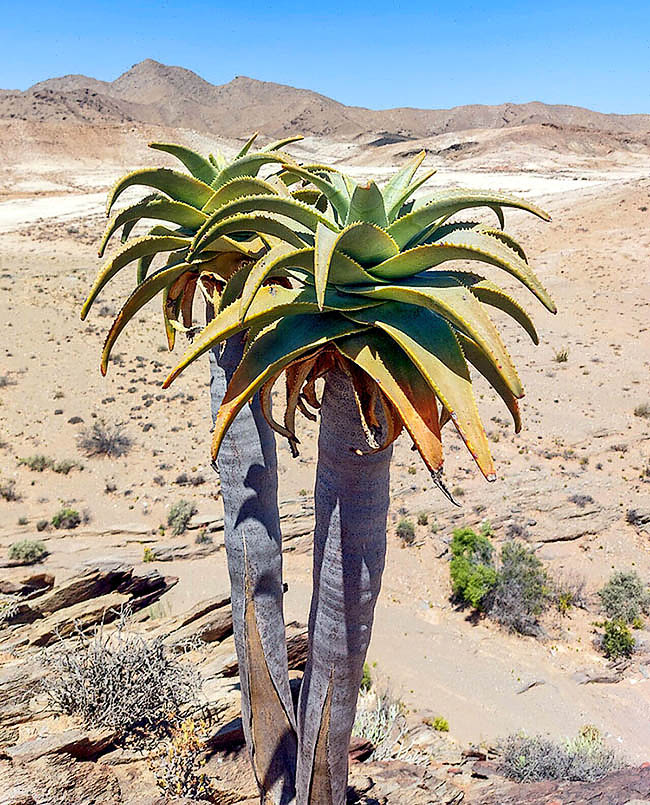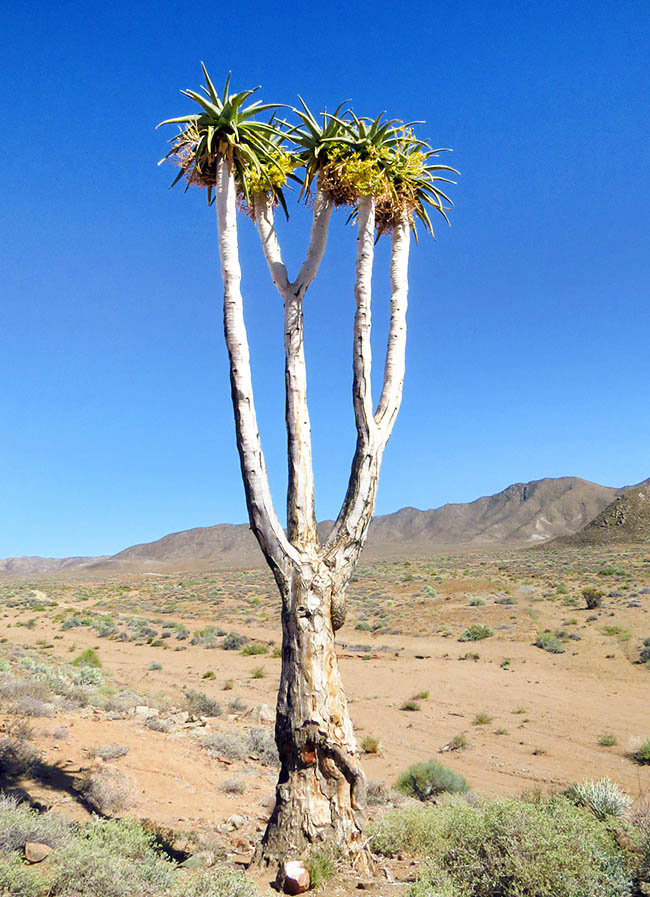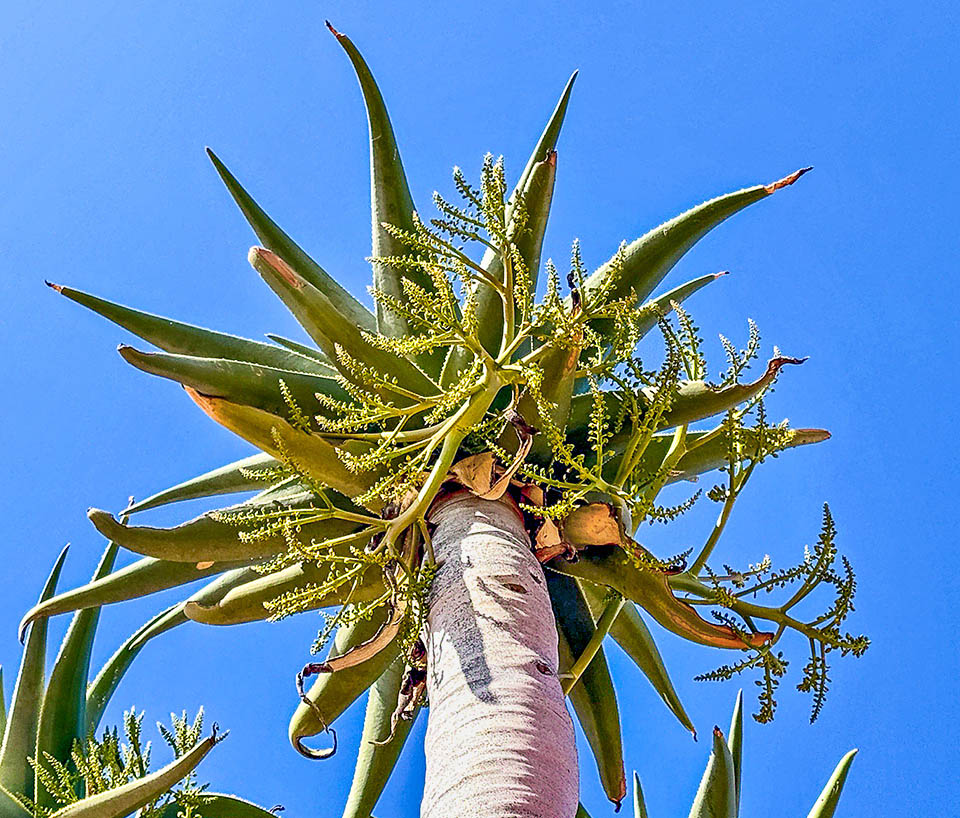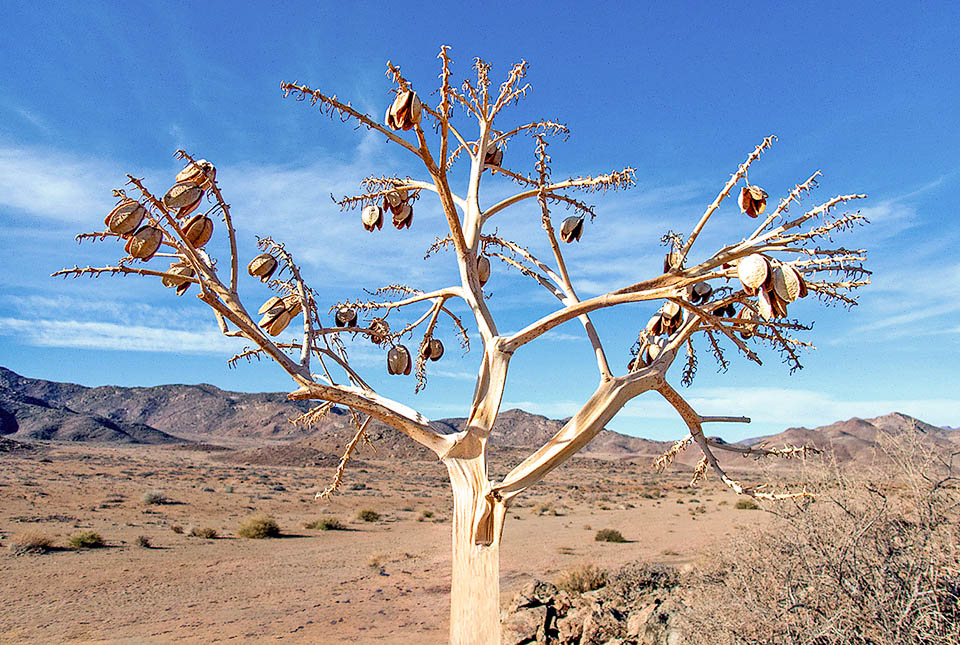Family : Asphodelaceae

Text © Prof. Pietro Pavone

English translation by Mario Beltramini

Aloidendron pillansii is an arboreal succulent species in critical danger of extinction © Hafeez Sonday
Aloidendron pillansii (L.Guthrie) Klopper & Gideon is a succulent plant discovered in October 1926 by the South African botanist Neville Stuart Pillans (1884-1964) in a remote arid stony hilly area of Anisfontein in the Richtersveld region, at the border with Namibia (South Africa).
It was described in 1928 by Luisa Guthrie (1879-1966) as Aloe pillansii in honour of its discoverer. Initially included in the genus Aloe being cognate to Aloe dichotoma (nowadays Aloidendron dichotomum) but differed in having less ramifications, bigger leaves and inflorescences with less protruding stamens.
In 2013 two botanists of South Africa, Ronell Renett Klopper (1974-) and Gideon Francois Smith (1959-), based on molecular data and on morphological characters, have thought appropriate to dismember the genus Aloe in order to put together only species belonging to one monophyletic group. Thus it was established the new genus Aloidendron (Phytotaxa 2013, 76(1):7-14) where are included plants with arboreal or shrubby habit with dichotomous branching and succulent leaves; Presently to this genus belong six species native to austral Africa including one of Somalia.
These are arborescent succulent plants that are considered indicator species of the deserts ecosystems for their size, up to 12 metres in height, as well as for the long lifespan, from 300 to 450 years. They have a remarkable tolerance to heat and live where the summer temperatures may exceed the 50 °C. Therefore the species of the genus Aloidendron are icons of southern Africa deserts. The genus is characterized by species having a chromosome number of 2n = 14.
Vulgarly Aloidendron pillansii is called “giant quiver tree”, from the African term “reuse kokerboom” alluding to the big size of its hollow stems compared to those of the related species Aloidendron dichotomum the Bushmen used for realizing quivers, containers for arrows that they carried hanging from the belt, the saddle of a horse or on the back.
Another vulgar name is “bastard quiver tree” so called because in the region of Richtersveld exist human populations racially mixed (biracial) that are formed by descendants of indigenous Africans and European settlers.
The etymology of Aloidendron is a combination of the name of the genus “Aloe” assigned by Pliny (maybe from the Greek ἅλς, ἁλός háls, halós, sea, salt or from the Arabic aluat bitter, due to the taste of the juice) and from “dendron”, that in Greek means tree. Consequently the compound name describes the distinctive characteristic of the genus as it includes plants with arboreal posture.
The specific name comes from its discoverer, Neville Stuart Pillans.

Grows between Namibia and South Africa, in deserts exceeding 50 °C, can be 12 m tall and get 300-450 years old © Joachim Louis
Aloidendron pillansii is an arborescent plant, perennial, succulent, with dichotomous ramifications and often longitudinally fissured bark. The stem is covered by a dusty white substance, especially in the younger specimens. The bark is of yellow-brownish colour and comes off with the age of the plant, leaving sharp edges in the lower part of the stem.
The leaves, merged in apical rosettas, are curved and lanceolate (50-60×10-12 cm), of grey-green or green-brownish colour, with smooth surface both above and below. The margins of the leaves display small, 1-2 mm long, white teeth 5-8 mm far from each other.
The young leaves have a glaucous appearance which is also a distinctive character for distinguishing the species from those strictly related like, for instance, Aloidendron dichotomum (Masson) Klopper & Gideon F.Sm.
The inflorescence is a panicle, about 50 cm long, extending horizontally upwards with single, up to 15 cm long, racemes and with up to 30 flowers. The inflorescence forming among the lowest leaves is hanging down.
The more or less 50 mm long flowers, have six merged tepals and form a tubular structure (perigone) of yellow colour.
The stamens and the styles are straight with glabrous filaments, usually not very protruding from the opening of the flower.
The flowering begins in late spring (October) or early summer (December) but during the drought periods may not occur.
The flowers produce an abundant nectar that attracts ants, bees and birds of the family Nectariniidae.
In fact, have been observed long-beaked nectarivorous birds like the Malachite sunbird (Nectarinia famosa) and the Cape sugarbird (Promerops cafer). Also the Southern double-collared sunbird (Cinnyris chalybeus) and the Orange-breasted sunbird (Anthobaphes violacea) are birds seen on the flowers of Aloidendron dichotomum but, due to their relatively short beak, that hardly reaches the base of the flowers, could steal the nectar by piercing the perigonium at the bottom, as has been observed in other species of Cape sugarbirds with an equally long perigonium.
The fruits are spherical capsules that begin to ripen during the month of December. The dehiscence occurs through the cracks along the sutures of the carpels (septicidal capsule) and releases the numerous seeds, of papery consistency, that are dispersed by the wind (anemochorous dispersal).
The seeds germination happens only if water is present on the ground and during the first 3-5 years from the germination are necessary abundant annual rainfalls. In the dry soil the seeds can remain viable for up to 5 years.

The inflorescence, hanging among the lowest leaves, is an about 50 cm panicle bearing even 30 flowers rich in nectar to attract ants, bees and birds © Karel du Toit
Aloidendron pillansii is a species classified by the IUCN Red List as CR, Critically Endangered, due to different factors that have compromised its habitat. In fact, during the last years, there was a higher mortality rate of the young plants because of the illegal collection for commercial purposes as well as due to the goats and donkeys overgrazing. Moreover, the prolonged drought, caused by the climate changes, since 2015 causes a decrease in the available forage obliging the animals, usually baboons, to prey on this plant.
According to a recent assessment it is thought that the number of individuals of Aloidendron pillansii has reduced by at least 61% during the last 300 years. So today there remain less than 9.000 specimens that justify its status of critically endangered. Presently most of the specimens are located inside the Ai-Ais/Richtersveld Transfrontier Park, a vast area with mountain desert landscapes that includes the Richtersveld National Park of South Africa and the Park of the thermal sources of Ai-Ais Hot Springs Game Park in Namibia.
In order to increase the number of plants to reintroduce, the South African National Parks (SAN Parks) has distributed seeds to various nurseries and traders, but the irreversible changes in the habitat, also due to the mining activities, have rendered the project impossible to realize.

The fruits are spherical capsules that open along the carpels sutures releasing several seeds of papery consistence dispersed by the wind © Andrew Hankey
For reducing the risk of extinction, this species has been included in the Convention on International Trade in Endangered Species of Wild Fauna and Flora (CITES) and also, South Africa has deemed necessary to protect it with its law concerning the Conservation of the Biodiversity and of the Genetic Resources (National Environmental Management: Biodiversity Act 10 of 2004). In this way, for the export will be required, besides the CITES permission, also the national permission.
Aloidendron pillansii has no known medicinal uses like Aloe vera, but is a species very appreciated in gardening, in fact, it is possible to find it in the private and public gardens of all southern Africa. At times, in some areas subject to fires , various individuals of this species are utilized as natural firebreaks around homes.
The plant grows well in the sun and with little water in sandy soil, rocky and well drained. In fact, the leaves and the succulent roots, as well as the fibrous and swollen stems, act as water reserves and the grey powder in the stems reflects the intense heat far away from the plant.
In the past the indigenous population has utilized the fibrous wood of the dead trees, that has cooling properties, for conserving water and food.
